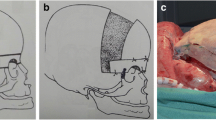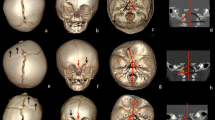Abstract
Purpose
The deformation of the skull base in patients with unilateral frontal plagiocephaly (UFP) is well known, but the mechanism is not still clear. We analyzed the skull base in the patients with UFP who underwent fronto-orbital advancement (FOA) in the early life during the last decade.
Methods
We assessed the treatment results and outcome of FOA performed in six patients, four girls and two boys younger than 2 years, in the last decade. Also, the basal cranium’s angles were measured by 3D reconstruction images on computed tomography (CT) scan.
Results
The mean patients’ age at FOAs was 11 months. Two cases were classified as grade 2A, two cases as grade 2B, and two cases as grade 3 (the classification of Di Rocco and Velardi). The ethmoidal axis was deviated a mean of 8.2° to the affected side. The mean angle between the petrosal pyramids and the midline (anterior-petrosal-sagittal angle, APSA) was 75.3° on the affected side and 66.2° on the normal side. The mean difference of APSA was 9.2°. On the follow-up CT images 5 years after surgery, the deviations of the ethmoidal axis clearly decreased, 5.7°, but the differences of APSA did not change, 8.8°.
Conclusions
The midline distortion of anterior skull base should be considered to be spontaneously corrected during the follow-up periods in patients with all types of UFP who underwent FOA, unlike posterior skull base in the patients with grades 2B and 3 classification.



Similar content being viewed by others
References
Kane AA, Kim YO, Eaton A, Pilgram TK, Marsh JL, Zonneveld F, Larsen P, Kreiborg S (2000) Quantification of osseous facial dysmorphology in untreated unilateral coronal synostosis. Plast Reconstr Surg 106(2):251–258
Hardesty RA, Marsh JL, Vannier MW (1991) Unicoronal synostosis. A surgical intervention. Neurosurg Clin N Am 2(3):641–653
Stricker M, Van der Meulen JC, Raphael B (1990) Craniofacial malformations. Churchill Livingstone, Edinburgh, pp 234–242
Marianetti TM, Gasparini G, Moro A, Alimonti V, Cervelli D, Boniello R, Di Rocco C, Saponaro G, Pelo S (2011) Nasal and ethmoidal alterations in anterior synostotic plagiocephaly. J Craniofac Surg 22(2):509–513
Di Rocco C, Paternoster G, Caldarelli M, Massimi L, Tamburrini G (2012) Anterior plagiocephaly: epidemiology, clinical findings, diagnosis, and classification. A review. Childs Nerv Syst 28:1413–1422
Di Rocco C, Velardi F (1988) Nosographic identification and classification of plagiocephaly. Childs Nerv Syst 4(1):9–15
Pelo S, Tamburrini G, Marianetti TM, Saponaro G, Moro A, Gasparini G, Di Rocco C (2011) Correlations between the abnormal development of the skull base and facial skeleton growth in anterior synostotic plagiocephaly: the predictive value of a classification based on CT scan examination. Childs Nerv Syst 27(9):1431–1443
Hansen M, Padwa B, Scott RM, Stieg P, Mulliken JB (1997) Synostotic frontal plagiocephaly: anthropometric comparison of three techniques for surgical correction. Plast Recontr Surg 100:1387–1395
McCarthy JG, Glasberg SB, Cutting CB, Epstein FJ, Grayson BH, Ruff G, Thorne CH, Wisoff J, Zide BM (1995) Twenty-year’s experience with early surgery for craniosynostosis. II. The craniofacial unsolved problems. Plast Reconstr Surg 96:284–298
Selber JC, Brooks C, Kurichi JE, Remmen T, Sonnad SS, Whitaker LA (2008) Long-term results following fronto-orbital reconstruction in nonsyndromic unicoronal synostosis. Plast Reconstr Surg 122:251e–260e
Mesa JM, Fang F, Murazko KM, Buchman S (2011) Reconstruction of unicoronal plagiocephaly with a hypercorrection surgical technique. Neurosurg Focus 31:1–8
Hilling DE, Mathijssen IMJ, Mulder PGH, Vaandrager JM (2006) Long-term aesthetic results of frontoorbital correction for frontal plagiocephaly. J Neurosurg 105(1 Suppl Ped):21–25
Matushita H, Alonso N, Cardeal DD, de Andrade F (2012) Frontal-orbital advancement for the management of anterior plagiocephaly. Childs Nerv Syst 28:1423–1427
Bentley RP, Sgouros S, Natarajan K, Dover MS, Hockley AD (2002) Changes in orbital volume during childhood in cases of craniosynostosis. J Neurosurg 96(4):747–754
Fearon JA, Ruotolo RA, Kolar JC (2009) Single sutural craniosynostoses: surgical outcomes and long-term growth. Plast Reconstr Surg 123(2):635–642
Author information
Authors and Affiliations
Corresponding author
Rights and permissions
About this article
Cite this article
Oyoshi, T., Fujio, S., Bohara, M. et al. The assessment of relationship between the skull base development and the severity of frontal plagiocephaly after bilateral fronto-orbital advancement in the early life. Childs Nerv Syst 30, 155–159 (2014). https://doi.org/10.1007/s00381-013-2182-9
Received:
Accepted:
Published:
Issue Date:
DOI: https://doi.org/10.1007/s00381-013-2182-9




